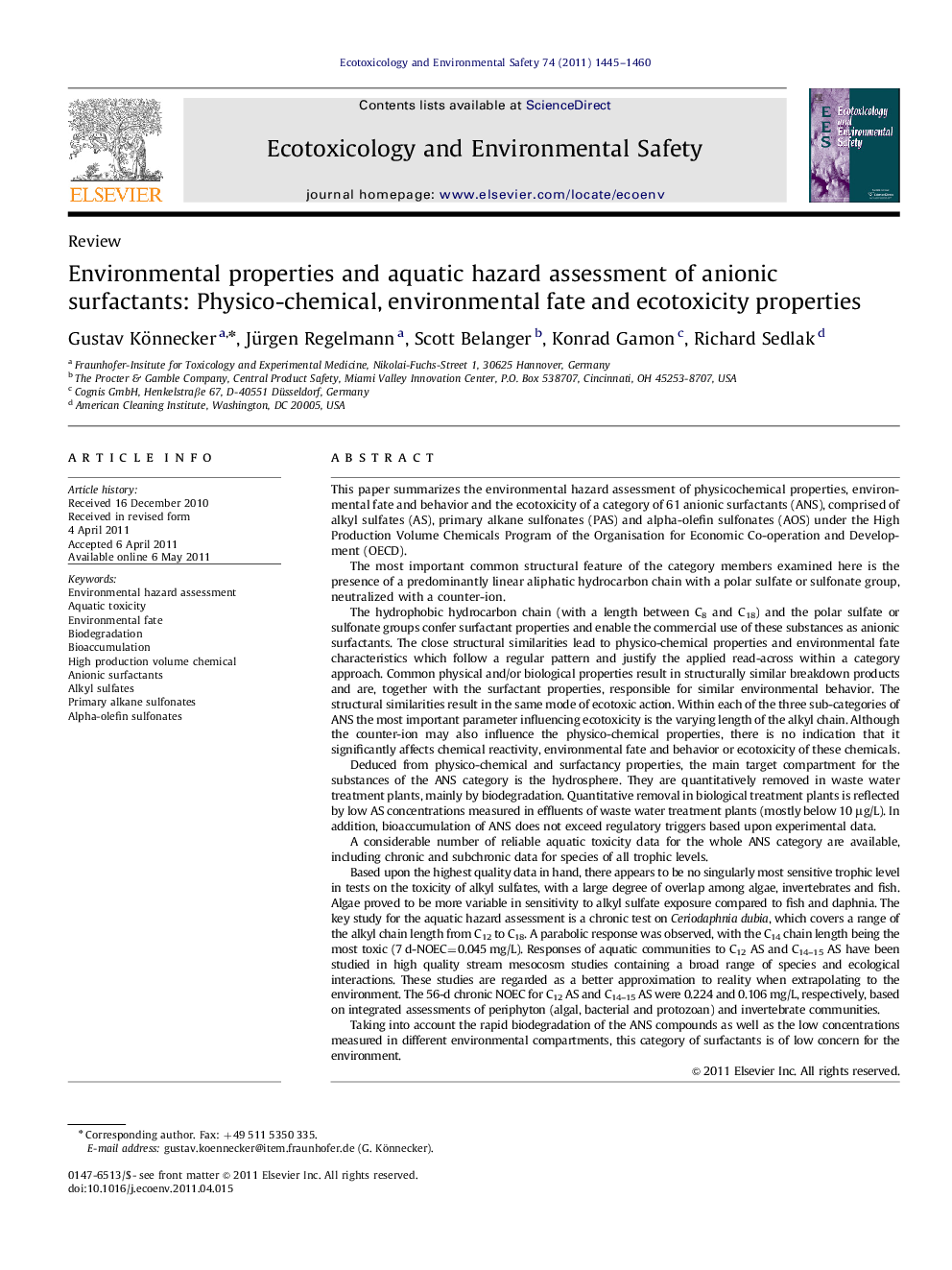| کد مقاله | کد نشریه | سال انتشار | مقاله انگلیسی | نسخه تمام متن |
|---|---|---|---|---|
| 4421074 | 1308504 | 2011 | 16 صفحه PDF | دانلود رایگان |

This paper summarizes the environmental hazard assessment of physicochemical properties, environmental fate and behavior and the ecotoxicity of a category of 61 anionic surfactants (ANS), comprised of alkyl sulfates (AS), primary alkane sulfonates (PAS) and alpha-olefin sulfonates (AOS) under the High Production Volume Chemicals Program of the Organisation for Economic Co-operation and Development (OECD).The most important common structural feature of the category members examined here is the presence of a predominantly linear aliphatic hydrocarbon chain with a polar sulfate or sulfonate group, neutralized with a counter-ion.The hydrophobic hydrocarbon chain (with a length between C8 and C18) and the polar sulfate or sulfonate groups confer surfactant properties and enable the commercial use of these substances as anionic surfactants. The close structural similarities lead to physico-chemical properties and environmental fate characteristics which follow a regular pattern and justify the applied read-across within a category approach. Common physical and/or biological properties result in structurally similar breakdown products and are, together with the surfactant properties, responsible for similar environmental behavior. The structural similarities result in the same mode of ecotoxic action. Within each of the three sub-categories of ANS the most important parameter influencing ecotoxicity is the varying length of the alkyl chain. Although the counter-ion may also influence the physico-chemical properties, there is no indication that it significantly affects chemical reactivity, environmental fate and behavior or ecotoxicity of these chemicals.Deduced from physico-chemical and surfactancy properties, the main target compartment for the substances of the ANS category is the hydrosphere. They are quantitatively removed in waste water treatment plants, mainly by biodegradation. Quantitative removal in biological treatment plants is reflected by low AS concentrations measured in effluents of waste water treatment plants (mostly below 10 μg/L). In addition, bioaccumulation of ANS does not exceed regulatory triggers based upon experimental data.A considerable number of reliable aquatic toxicity data for the whole ANS category are available, including chronic and subchronic data for species of all trophic levels.Based upon the highest quality data in hand, there appears to be no singularly most sensitive trophic level in tests on the toxicity of alkyl sulfates, with a large degree of overlap among algae, invertebrates and fish. Algae proved to be more variable in sensitivity to alkyl sulfate exposure compared to fish and daphnia. The key study for the aquatic hazard assessment is a chronic test on Ceriodaphnia dubia, which covers a range of the alkyl chain length from C12 to C18. A parabolic response was observed, with the C14 chain length being the most toxic (7 d-NOEC=0.045 mg/L). Responses of aquatic communities to C12 AS and C14–15 AS have been studied in high quality stream mesocosm studies containing a broad range of species and ecological interactions. These studies are regarded as a better approximation to reality when extrapolating to the environment. The 56-d chronic NOEC for C12 AS and C14–15 AS were 0.224 and 0.106 mg/L, respectively, based on integrated assessments of periphyton (algal, bacterial and protozoan) and invertebrate communities.Taking into account the rapid biodegradation of the ANS compounds as well as the low concentrations measured in different environmental compartments, this category of surfactants is of low concern for the environment.
Journal: Ecotoxicology and Environmental Safety - Volume 74, Issue 6, September 2011, Pages 1445–1460